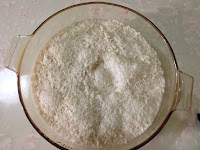This is my second attempt to make this. The first time, I left the rice to ferment to more than 20-21 days. There was a recipe that said as long as possible but it did not work for me - the resulting liquid was more like vinegar.
So, for this second time, I cooked the glutinous rice in the rice cooker, instead of trying to steam it to get nice whole grains with less starchiness. Steaming in my wok for such a lot of rice doesn't work well. And I will harvest the wine at 20-21 days' time.
Harvest
So, for this second time, I cooked the glutinous rice in the rice cooker, instead of trying to steam it to get nice whole grains with less starchiness. Steaming in my wok for such a lot of rice doesn't work well. And I will harvest the wine at 20-21 days' time.
 |
| Cooked 1 kg (and a bit more) of glutinous rice in the rice cooker. First layer ... |
 |
| 3 pieces of wine biscuit per kg of rice. |
 |
| Pounding in this metal plate doesn't work for the initial big pieces. Did that in a sealed plastic bag, then back to this plate. |
 |
| Pounded the wine biscuit to almost powder form. |
 |
| Added wine biscuit powder to first layer of rice. |
 |
| Next layer of rice and wine biscuit. |
 |
| Third layer. |
 |
| Added about half a cup of water, pressed the rice down. |
 |
| Smoothed the top layer, made a hole for fun! |
 |
| Cut up old T-shirt, washed and dried to cover the pot. Held in place by rubber bands. Cover. |
 |
| Started on 25 Sep 2016, to be harvested on 15 Oct 2016. |
 |
| 28 Sep 2016: A layer had formed and the alcohol smell had been strong these past few days. |
 |
| Bought this salt-less rice wine from NTUC $2.80. Some say that salty cooking wine is also ok. |
 |
| 28 Sep 2016: Added rice wine. 160ml. Supposed to be half bottle per kg of rice. But how much is half bottle? At half way point, checking ... |
 |
| 4 Oct 2016: I thought it was a solid mass, until I tilted the bowl a little. There's lot of liquid in there! |
Harvest
 |
| 15 Oct 2016: First taste - it is sweet. |
 |
| Harvest on 16 Oct 2016. |
 |
| Let it drip without pressing the residue. |
 |
| Quite a lot. |
 |
| Bottle up the first harvest. Then press the liquid from the residue. |
 |
| 2 taller bottles contain the 1st drip-only wine. Red cap bottle contains the residue. Maybe I can cook with this ... |
Comments
Post a Comment